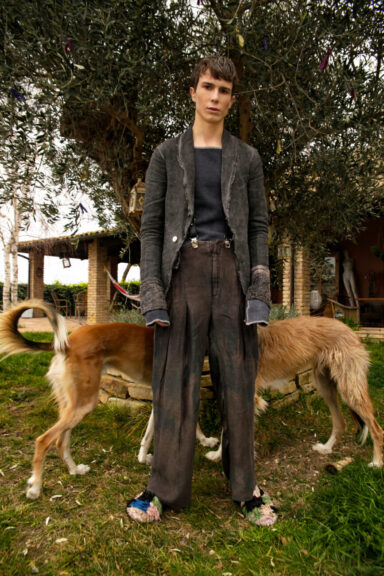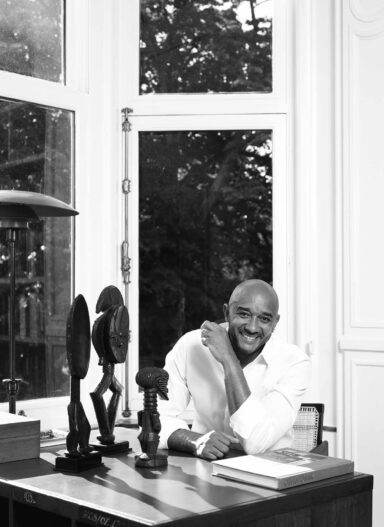PHOTOGRAPHER ARTURO DELLE DONNE MADE HIS WIFE AND KIDS THE MODELS OF A QUARANTINE FASHION STORY WHERE HOME TURNS INTO A NOSTALGIC HOPPER’S CANVAS
Interview by Fiammetta Cesana
(Below in Italian)
Writer contributors Andrea Tinterri and Diletta Accorroni

Photographer Arturo Delle Donne
Models Claudia, Alberto, Andrea Delle Donne
A special thanks to Francesca Meletti of Gaudenzi Boutique and Suprema (supermalab.com)
All the clothes are available in Gaudenzi Boutique stores and online at gaudenziboutique.com
Cover photo: She wears kimono Etro, slides Casadei – He wears T-shirt MISBHV

“It will be difficult to rearrange the photographic material produced in this period, in these last months. A quarantine that went viral, the network and social media showed a hypertensive, hyperactive, heart-pounding photography, close to a nervous breakdown. All predictable: a productive anxiety in a moment of stasis, of social poisoning (also inflamed by a solidarity that I often consider fleeting and therefore insane).
In these two months I have absently observed most of the images that appeared on my display, to select only a few experiences which really bond with. Arturo Delle Donne, a month ago, started sending me whatsapp with some tests, exercises. Images of spaces (home): photographic approaches that were affected by his experience in the field of fashion, cinema, of that constructed photography that leaves nothing to chance.
Fortunately, his is not a diary: who cares of what you do confined to your home, what do you eat, what do you read, what do you listen to? Ominous gossip of condo and social media. Arturo remains a fashion photographer, stage photographer, he remains professional and stages. And it is the staging that preserves us from the insane desire to spy on something that we shouldn’t look at. Arturo Delle Donne does his job and does it well with the means he has at hand now. The quotes are the consequence of the synthesis, the selection of objects, attitudes, a reconstruction that is not emotional, but cultural.”
Andrea Tinterri

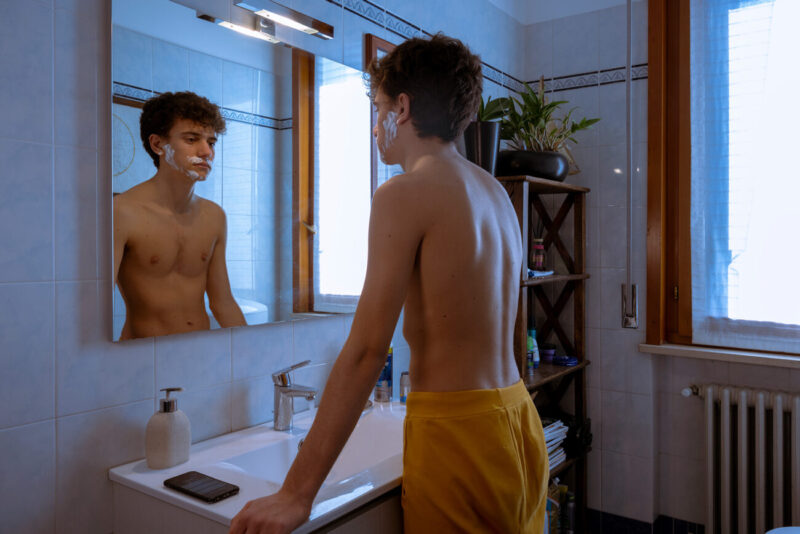
Fiammetta: Dear Arturo, looking at your photos, the artistic and cultural references appeared to me manifold, therefore I did my research. Edward Hopper’s works – to quote an artist that your images have reminded me of – are actually often bring up in this complicated historical moment: the melancholy of his home settings at the end of the war, in fact, seem to open a window on today’s quarantine. Yet, there are those who say that translating the plethora of his subjects into the iconography of city isolation is misleading and reductive.
Were you inspired by him? Or do you think that what we are experiencing is, in a certain sense, incomparable to another historical period, and consequently to its respective artistic representation?
Arturo Delle Donne: Much of this work had Hopper as its main inspiration, but not only. Hitchcock’s images, like that of Win Wenders. But also in some familiar parts of Stranger Things. In some shots my main source of inspiration was Yasujirō Ozu’s cinema with his masterpiece “A Tokyo Story”. They are part of my visual culture. My photos are like single frames of a scene that has to be unfold. A story of a very particular historical moment, which leaves the viewer the imagery of the sequence.
Surely the claustrophobia of this period was however the feeling that most inspired me. The historical moment is absolutely “original” but it is the perception of it that perhaps makes it so. Each of us thinks of living a unique and personal phase that cannot be compared to any other. For me it was a period of deep introspective work that led me to this result. I started several paths at the beginning of the lockdown then I concentrated on family dynamics that seemed universal or at least repeatable.
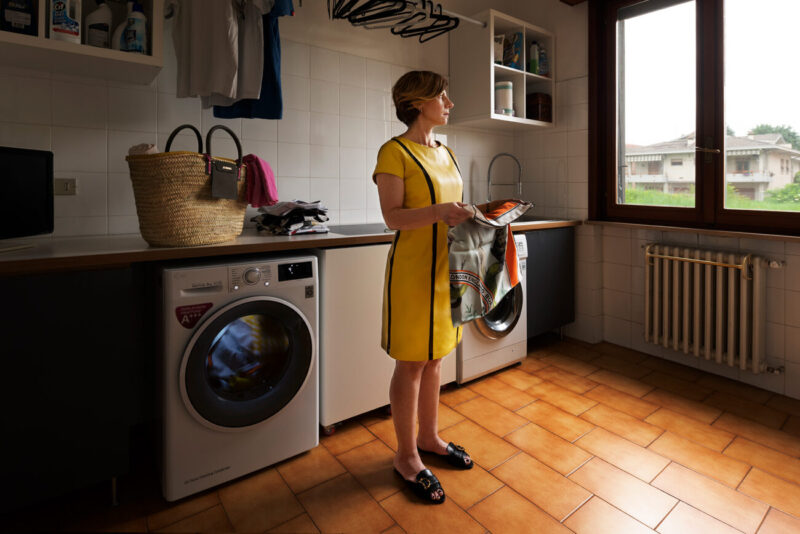
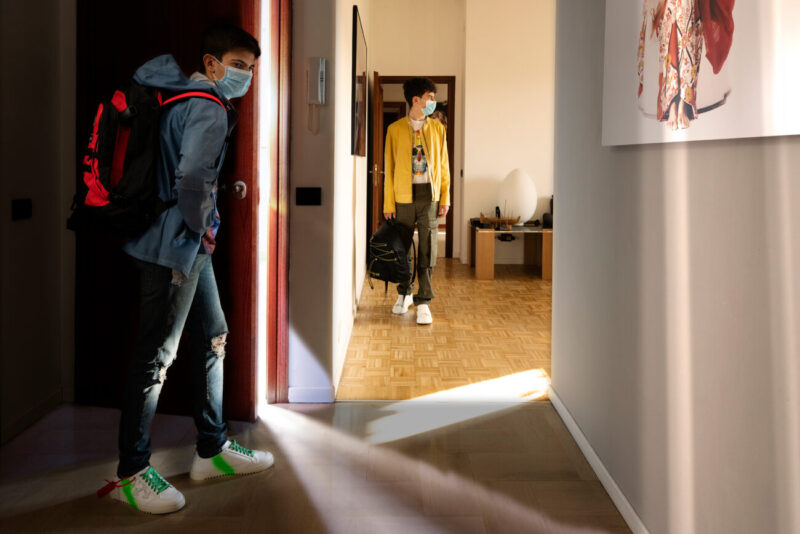
As you already mentioned, the second artist in question, who made the meditative and surreal dimension of Hopper’s paintings the cornerstone of his shots, is Alfred Hitchcock. “Rear Window” is the film that most of all claimed the ambiguity, but also the irrepressible human instinct, of voyeurism. Another window on the lockdown’s perturbation that seems to rivive in your photographs. Your subjects, which are your own family members, in fact, seem to be totally unaware of being observed and immortalized… was this your goal from the beginning?
Absolutely yes. Everything was thought as a film setting, rather than photographic, the subjects had to play a part. Unlike “Rear Window” the protagonists are revealed in the house, the observation point is more intimate inside, allowing the viewer to be part of family life. But as in Hitchcock’s masterpiece, the outside world arouses curiosity and above all desire through a glance, but the concept is similar.
Mine wanted to be an almost iconic description of an experience, not a personal story. A reconstruction of feelings, emotions and desires.

This artistic choice, furthermore, totally differs from the hypertensive and ultra-posed shots running on social networks these days, especially in the fashion field. Unlike Hopper and Hitchcock, you have another protagonist indeed: the clothes. Which direction do you think the fashion photography is moving to? The “meta-image” of the shootings made through videochat will have a future once overcome the quarantine?
Actually I think that fashion has and has played a fundamental role in cinema. Everything is studied in the Hitchcock films and many of Edith Head’s clothes have become iconic. But let’s also think of Givency’s collaboration with Audrey Hepburn’s shift dress in Breakfast at Tiffany’s or Armani who dressed Richard Gere in American Gigolo. Or Jean Paul Gaultier who dressed all the characters in the splendid film “Le Cinquième élément” by Luis Besson. In the latter film, clothes play a fundamental role in the narration and creation of the characters.
Even for me the role of the dress is important in the story. The intertwining of the arts unites them and makes them grow, creating more mature and complete visions.
Predicting the future of fashion photography is very difficult. Personally I don’t like uniformed styles, I like to tell in every photo shoot. The “meta-image” of this period is extremely fascinating. It turns out to be an experiment of considerable interest, certainly forced by the moment, which will develop into highly evolved experimental events.


It is not easy to create such a mystery and dreamlike aura using your wife and children as models within the walls of your own home. Yet it was Freud himself who highlighted the sense of strangeness caused by what is most familiar to us: our home. The psychoanalyst related the two terms “Heimlich”, and “Unheimlich”, both custodians of a double meaning, in-between familiarity and restlessness, warmth and hostility, revealed and hidden. According to Freud, the family was the main source of disturbing feelings. The forced cohabitation of the quarantine is definitely a test case. The house that is no longer a safe place but a harbinger of anxieties and fears, the “nest” that becomes “net”…
Do your domestic portraits reflect this transformation and dualism of emotions?
Probably the beauty of this project lies in the subjects I photographed, the delicacy that is captured is due to a real intimacy. Again we can say that Hopper was an inspiration to me, having used his wife as a model in many of his paintings. As well as being models, my children also acted as studio assistants. The method was very rigorous, the photographs were discussed together, the alarm clock was always at dawn to catch the right light that entered the house. The house was experienced as a comfortable environment, where all lifetime took place during the lockdown. The house was certainly the familiar, comfortable and intimate part.
However, the house is also the place where the secrets of a family are hidden. This contradiction is the basis of this work. The desire, despite the comfort, of the exterior that enters the house through the light of the windows. The desire for a hopeful tomorrow. An expectation that often seemed endless. But also the discovery of the interior, of the underwear for the first time, for a long time. A unique, unrepeatable opportunity that has made it possible to discover new balances and new interests. And finally the fear of leaving the warm house, the safe nest. After a long time the emotion of the outside is almost comparable to the emotion of the unknown.

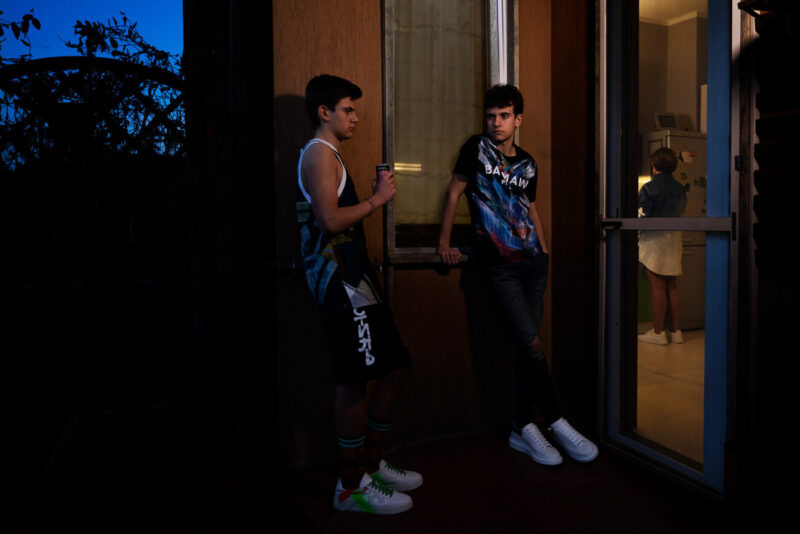
Fiammetta: Caro Arturo, guardando le tue foto i riferimenti artistici e culturali mi sono apparsi molteplici, e quindi ho fatto le mie ricerche. Le opere di Edward Hopper – per citare un artista che le tue immagini mi hanno ricordato – vengono effettivamente scomodate spesso in questo complicato momento storico: la malinconia delle sue abitazioni domestiche alla fine della guerra, infatti, sembra aprire una finestra sulla quarantena di oggi. Eppure, c’è chi dice che tradurre la pletora dei suoi soggetti in iconografia di isolamento cittadino sia fuorviante e riduttivo.
Tu ti sei ispirato a lui? O pensi che ciò che stiamo vivendo sia, in un certo senso, imparagonabile a un altro periodo storico, e di conseguenza alla sua rispettiva rappresentazione artistica?
Arturo Delle Donne: Gran parte di questo lavoro ha avuto come ispirazione principale il lavoro di Hopper, ma non solo. Le immagini di Hitchcock, come quello di Win Wenders. Ma anche in alcune parti familiari di Stranger Things. In alcune inquadrature la mia fonte di ispirazione maggiore è stato il cinema di Yasujirō Ozu con il suo capolavoro “Una storia di Tokyo”. Fanno parte della mia cultura dell’immagine. Le mie foto sono come fotogrammi singoli di una scena che deve svolgersi. Un racconto di un momento storico molto particolare, che lascia allo spettatore l’immaginario della sequenza.
Sicuramente la claustrofobia di questo periodo è stato però il sentimento che maggiormente mi ha ispirato. Il periodo storico è assolutamente “originale” ma è la percezione che forse lo rende tale. Ognuno di noi pensa di vivere un momento storico unico e personale imparagonabile a qualsiasi altro momento. Per me è stato un periodo di profondo lavoro introspettivo che mi ha portato a questo risultato. Ho iniziato diversi percorsi all’inizio del lockdown poi mi sono concentrato sulle dinamiche familiari che mi sono sembrate universali o almeno ripetibili.
Come hai appena menzionato, il secondo artista in questione, che della dimensione meditativa e surreale protagonista delle tele di Hopper ne fece il cardine delle proprie riprese, è Alfred Hitchcock. “Rear Window” è il film che più di tutti ha sancito l’ambiguità, ma anche l’irrefrenabile istinto umano, del voyeurismo. Un’altra finestra sul turbamento da lockdown che sembra rivivere nelle tue fotografie. I tuoi soggetti, infatti, nonché tuoi stessi famigliari, sembrano essere totalmente ignari di venire osservati e immortalati… era questo il tuo obbiettivo fin da principio?
Assolutamente si. Tutto è stato impostato come un set cinematografico, più che fotografico, i soggetti dovevano recitare una parte. A differenza di “Rear Window” i protagonisti sono svelati in casa, il punto di osservazione è interno più intimo, si permette allo spettatore di essere parte della vita familiare. Ma come nel capolavoro di Hitchcock il mondo esterno suscita curiosità e soprattutto desiderio attraverso uno sguardo, il concetto però è assimilabile.
La mia voleva essere una descrizione quasi iconica di un vissuto, non un racconto personale. Una ricostruzione di sentimenti, di emozioni e di desideri.
Questa scelta artistica, per altro, si discosta totalmente dagli scatti “ipertesi” e ultraposati che girano in questi tempi sui social, soprattutto in ambito moda. A differenza di Hopper e Hitchcock, infatti, tu hai un altro protagonista: l’abito. In che direzione pensi si stiamo muovendo la fotografia di moda? La “meta-immagine” dei servizi fatti tramite videochat avrà futuro superata la quarantena?
In realtà penso che la moda abbia ed ha avuto un ruolo fondamentale nel cinema. Tutto è studiato nei film di Hitchcock e molti abiti di Edith Head sono diventati iconici. Ma pensiamo anche alla collaborazione di Givency con il tubino di Audrey Hepburn in Breakfast at Tiffany’s o Armani che vestì Richard Gere in American Gigolò. Oppure Jean Paul Gaultier che veste tutti i personaggi nello splendido film “Le Cinquième élément” di Luis Besson. In quest’ultimo film gli abiti hanno un ruolo fondamentale nella narrazione e nella creazione dei personaggi.
Anche per me il ruolo del vestito è importante nel racconto. L’intreccio tra le arti le unisce e le fa crescere, creando delle visioni più mature e complete.
Prevedere il futuro della fotografia di moda è molto difficile. Personalmente non amo gli stili uniformati, mi piace raccontare in ogni servizio fotografico. La “meta – immagine” di questo periodo è estremamente affascinante. Risulta essere un esperimento di notevole interesse. Sicuramente forzato dal momento, che si svilupperà in eventi sperimentali molto evoluti.
Non è facile creare una simile aurea di mistero e onirico utilizzando come modelli la propria moglie e figli tra le mura di casa. Eppure fu proprio Freud ad evidenziare il senso di stranezza provocato da ciò che ci è più famigliare: la nostra casa. Lo psicoanalista metteva in relazione i due termini “Heimlich”, e “Unheimlich”, entrambi custodi di un doppio significato, a cavallo tra famigliarità e inquietudine, accoglienza e turbamento, svelato e nascosto. Secondo Freud infatti era proprio la famiglia la maggiore fonte di sentimenti disturbanti. E certo, la convivenza forzata della quarantena ne è sicuramente un banco di prova. La casa che non è più un luogo sicuro ma foriero di ansie e paure, il “nest” che diventa “net”…
I tuoi ritratti casalinghi riflettono questa trasformazione e dualismo di emozioni?
Probabilmente la bellezza di questo progetto sta nei soggetti che ho fotografato, l’intimità , la delicatezza che si coglie è dovuta ad un’intimità reale non costruita. Anche in questo caso possiamo dire che Hopper mi è stato di ispirazione, avendo egli stesso utilizzato, in molti suoi quadri, proprio sua moglie come modella. I miei figli oltre che da modelli hanno fatto anche da assistenti in studio. Il metodo è stato molto rigoroso, si sono discusse le fotografie insieme, la sveglia era sempre all’alba per cogliere la luce giusta che entrava in casa. La casa è stata vissuta come un ambiente confortevole, in cui si è svolta tutta la vita durante il lockdown. La casa è stata sicuramente la parte familiare, confortevole e intima.
La casa è però anche il luogo dove si celano i segreti di una famiglia. Questa contraddizione è alla base di questo lavoro. Il desiderio, nonostante il confort, dell’esterno che entra in casa attraverso la luce delle finestre. Il desiderio di un domani di speranza. Un’attesa che spesso poteva sembrare interminabile. Ma anche la scoperta dell’interno, dell’intimo per la prima volta, per tanto tempo. Un’occasione unica, irripetibile che ha permesso di scoprire nuovi equilibri e nuovi interessi. E infine la paura di uscire dalla calda casa, dal nido sicuro. Dopo tanto tempo l’emozione dell’esterno è quasi paragonabile all’emozione dell’ignoto.

